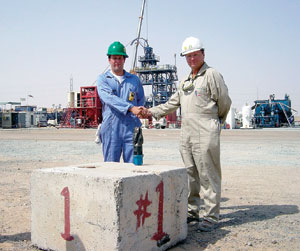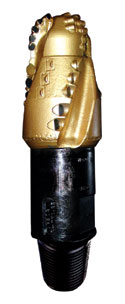Underbalanced Drilling
First true, CT underbalanced casing exit performed
At BP’s Sajaa field in Sharjah, UAE, engineers successfully employed a casing exit strategy based on PDC bit technology.
Jim McNicol and Cal Stowe, Baker Oil Tools, Houston, and Martin Geddes and Barry Webster, Baker Oil Tools, Aberdeen, Scotland
The world’s first true, coiled tubing-conveyed (CT) underbalanced casing exit was performed last summer in BP’s Sajaa field, in Sharjah, United Arab Emirates. This CT underbalanced casing exit overcame the final barrier to a fully underbalanced, sidetracking re-entry operation that was crucial to continued re-development of Sajaa field, Fig. 1.
 |
Fig. 1. Sharjah team members Scott Fraser (BOT) and Randy Pruitt (BP) congratulate one another for successfully conducting a coiled tubing underbalanced casing exit.
|
|
A key enabler of the operation was a new casing exit technology that is based on polycrystalline diamond compact (PDC) bit technology. It is designed to mill one-trip casing exits through high alloy or chrome casings and difficult-to-mill/ drill formations.
SAJAA FIELD ISSUES/ PROPOSED SOLUTION
Sajaa field produces gas from the Thamama carbonate formation. Gas from the field is used to supply the entire electricity requirement of the emirate of Sharjah.
Production rates were declining in Sajaa field. Coiled tubing underbalanced drilling was identified as the best recovery solution, so a massive campaign was begun in April 2003. Because of the field’s role in supplying power, one critical success factor for the CT drilling campaign was that the gas supply should suffer as few interruptions as possible.
To date, 22 multilateral wells have been completed in Sajaa, with a total of 150,000 ft of formation drilled. All drilling is performed with nitrogen gas and water to ensure underbalanced conditions. However, early attempts to mill windows in a similar fashion proved unsuccessful because of the inability of the gas to cool the natural diamonds in conventional window mills. Windows were milled using water, which created an overbalanced condition that interrupted gas production and caused water loss to the formation. Having determined that the risk to future high-rate wells was too great to continue in this manner, BP sought a nitrogen milling solution.
The goal was to cut a casing window to expose more production zone, and to do so with minimal formation damage. The proposed solution was to cut the exit with nitrogen as the primary circulating fluid, and inject a water/ mineral oil emulsion to lubricate and cool the motor and mill. Plans called for the water injection rate to be adjusted to maintain positive wellhead pressure while milling, to help keep water out of the formation. The theory was that well production and nitrogen would circulate most of the injected water out of the well.
 |
Fig. 2. A typical formation window mill used in the CT underbalanced casing exit.
|
|
TECHNOLOGICAL SOLUTION
Baker Oil Tools (BOT), in conjunction with Hughes Christensen and Baker Hughes Inteq, developed and tested six mill solutions designed specifically for the Sajaa application. The test program included nitrogen testing in a hyperbaric chamber. The combination that was selected for the project included a Navi-Drill Xtreme air-driven motor and a BOT PathMAKER window/ formation mill, Fig. 2.
Operational constraints included:
- Being able to run tools through 3.9-in. ID production tubing
- Milling a window out the side of 6-in. bore casing with 1/2-in. wall
- Providing a 3.8-in. diameter whipstock that would set in a 6-in. bore
- Conveying tools with coiled tubing
- Milling within the torque limit of a 2-7/8-in. motor powered with nitrogen (which further reduced torque output)
- Running in a live well producing gas under pressure, with a surface seal on the coil.
The casing exit solution had to satisfy these design challenges. Finally, it was crucial that the mill not only cut the steel, but also drill formation at an acceptable rate.
Conventional carbide cutter mills, with their aggressive, carbide cutting structures and backup string reamers, have historically required excessive torque and resulted in numerous motor stalls. The time to cut an exit exceeded 20 hr. Two or more mills and trips were required, particularly in hard and abrasive formations, due to premature wear on the cutting elements.
The mill uses PDC technology to reliably cut one-trip casing exits, and extended rat holes, in limestone or sandstone that previously required two or more trips. The mill’s thermally stable cutters minimize the requirement for cooling and lubrication, thus enabling them to mill alloy, stainless steel and formation. Cutter layouts are designed for maximum penetration rates and are arranged in a specially engineered, spiral alignment that reduces vibration while enabling smoother, cleaner cuts. The blade design and hydraulic configuration provide large water courses that direct drilling fluid to efficiently clean and cool the cutter elements for increased endurance.
SAJAA CASING EXIT
The nitrogen gas-based, CT underbalanced casing exit technology was applied in the Sajaa 19 well during June 2004. The window and formation rat hole were completed in a single milling trip through a 7-in., 35-lb/ft liner at a depth of 11,424 ft, MD, and a temperature of 300°F.
A small amount of water was misted into the nitrogen flow to provide some lubrication for the motor bearings. The milling rate of progress was significantly greater than for previous windows milled in this project. Milling was performed using the drilling CT reel (with e-line), which eliminated the need to change to a work reel. This resulted in a 60% decrease in operating time versus the previous average.
It also resulted in a 97% reduction in the amount of water introduced to the wellbore – 175 bbl – compared to the previous average of 5,000 bbl. Reservoir damage was all but eliminated, and production continued uninterrupted. The system has been used in two additional wells with operating time further reduced each time. Window milling with nitrogen has enabled future development of the field by allowing high-rate production wells to be sidetracked. 
THE AUTHORS
|
| |
Jim McNicol is a senior engineering manager with Baker Oil Tools (BOT) in Houston, responsible for new product development in Fishing and Exit Systems. He was previously engineering manager of the UK Well Intervention Group that managed the Sharjah project from Aberdeen, Scotland. He and his team recently won the 2004 Scottish Offshore Achievement Award for Innovative Technology. Mr. McNicol joined BOT in 1995 and has more than 25 years of experience. He holds a BS degree in mechanical engineering with distinction from the Robert Gordon University in Aberdeen and an education degree from the University of Strath-clyde in Glasgow, Scotland.
|
|
Cal Stowe has been with Baker Hughes for 25 years and is team leader of the PDC exit mill project that developed the PathMAKER™ product line used in Sharjah. Mr. Stowe holds a BS degree in mechanical engineering from Rice University, and he was a George R. Brown Academic Scholarship recipient. He is a registered professional engineer in Texas. He and his team won the 2004 World Oil Award for Best Drilling Technology.
|
| |
Martin Geddes joined BOT in 1995 after graduating from Robert Gordon University in Aberdeen with a degree in mechanical engineering. He is engineering manager for the UK Well Intervention Group. He is a chartered engineer and member of the Institution of Mechanical Engineers (IMechE) and also the 2005 Chairman of the European Chapter of the International Coiled Tubing Association (ICoTA).
|
| |
Barry Webster is project manager in the BOT Exit Technology Group in Aberdeen. He has more than 15 years experience in North Sea coiled tubing and through-tubing projects, having joined Baker Oil Tools in 1997. Mr. Webster manages fishing, milling and whipstock services for the BP Sharjah UB CTD project.
|
|




